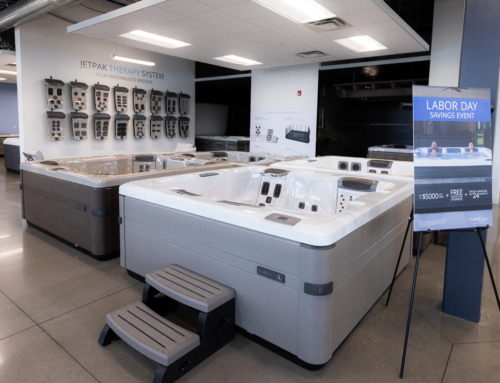Admittedly, planning is not a lot of fun. But, hope is not a strategy and planning works.
Every retail business—including a hot tub dealership—can benefit from a comprehensive marketing plan. In fact, multiple studies show a formal marketing plan is positively related to and largely determines business performance, particularly when selling consumer products in highly competitive environments. Entrepreneur magazine claims, “Firms that are successful in marketing invariably start with a marketing plan.” Not only does the marketing plan serve as a roadmap for your business, but it also can help motivate employees towards achieving specific sales goals.
...time spent developing your marketing plan is time well spent because it defines how you connect with your customers. And that’s an investment worth making.
Ideally, businesses should create marketing plans on an annual basis and revise as necessary when launching a new product or service. Although it can be challenging for small businesses to dedicate such time and resources to planning, the process should be viewed as an investment. According to the US Small Business Administration, “At the end of the day, the time spent developing your marketing plan is time well spent because it defines how you connect with your customers. And that’s an investment worth making.”
So, whether you are starting a new hot tub store or just presenting a new product line to your target market, the value of a strong marketing plan shouldn’t be underestimated. But where do you begin? Here’s a simple approach specific for you and your spa business that you can use to guide you through the planning process.
Set Specific Marketing Objectives
A solid marketing plan starts with specific and measurable marketing objectives. For a hot tub dealer, that might include goals such as increasing your average sale amount with upselling, increasing profit margin by selling value, or increasing the frequency of customer purchases with special incentives for chemicals, accessories, or trade-ins.
To develop your business’s marketing objectives, ask yourself these questions and write down the answers:
- What do you hope to achieve in sales, market share, new customer acquisitions, and enhanced brand recognition within your marketplace?
- What actions can you take to achieve your goals?
- Who is your target customer?
- What are your metrics for success?
- What is your timeframe for achieving your objectives?
With these answers, you’ll be able to get a better view of the “why” behind your marketing efforts.
SWOT Analysis (Strengths, Weaknesses, Opportunities, and Threats)
 Luckily, SWOT does not refer to a bunch of elite officers showing up in heavily armored vehicles to free hostages.
Luckily, SWOT does not refer to a bunch of elite officers showing up in heavily armored vehicles to free hostages.
SWOT in this case refers to strengths, weaknesses, opportunities, and threats. The process of a SWOT analysis simply helps you to identify where your business stands by showing what your company’s strengths are, what things your company can improve, what opportunities your company can take advantage of, and what threats your business faces now or may encounter in the future.
In conducting your SWOT Analysis, you will have to consider conditions and trends that affect the spa business as a whole—such as the current market interest in specific wellness products. You will also have to evaluate all of the different factors that relate only to your specific marketplace—the local economic climate, whether or not your town is having a parade this weekend.
Strengths
What advantages does your company have, and what do you do better than any other spa retailer?
Weaknesses
What are people in your market likely to see as a weakness about your business?
Opportunities
What are the positive factors working in your favor right now, such as market trends, new customers, and enhanced technology?
Threats
What are your obstacles (such as bad debt or cash-flow problems) and how can they affect your business?
Set Specific Strategies
Once you know what your goals are and where you stand currently, it’s time to strategize. The strategies section of your marketing plan should outline exactly how you intend to achieve your business goals and targets with the resources you have, thinking specifically about how you want to present your company’s brand to your customers.
These are the types of strategies that you can include in your marketing plan:
Pricing Strategy
How do your prices compare with the competition’s prices and how does that help you both attract more business and create higher profits? Low prices can increase store traffic. However, keep in mind that maintaining the lowest price can be a dangerous and unsustainable strategy, and can say something to your customers about your overall value proposition. One entry level spa that can be priced attractively may be enough. When you are selling at a higher price with the best quality and technology, your pricing strategy then focuses on positioning your brand and your products as the very best, building value and trust.
Product Strategy
How can your products meet the needs and wants of your current and prospective customers? Find products that increase the frequency of customer purchases like regularly needed chemical systems, filters, etc. With high frequency items, always ask for additional sales. Sounds silly, but the fast-food approach of “Do you want fries with that?” works; and more than one brand new spa has been sold to a chemical customer because the salesperson asked.
Also, analyze what products can help you increase the total ticket amount of your purchases and the profit margin. This could include more high-end spas, a bigger selection of specialized cover-lifters, upgraded covers, or premium chemicals.
Promotions Strategy
How can you promote your products to customers? This includes money-back guarantees, limited time promotional offers, initial purchase discounts, or free accessories. You could also consider off-site events, joint venture offers with other businesses, trade-in offers, or a free spa trial program. Don’t forget to incorporate media into your promotions strategy including print, broadcast, radio, websites, Search Engine Marketing (SEM), social media networking, direct response, and guerilla (no or low-cost) marketing methods. You probably don’t need to do all of these, but you do need to do more than one to ensure adequate coverage.
Placement Strategy
This is how you bring your product to your market. Placement includes where your business is located, where you show product, and how products are offered. Have you thought about all the places in your market where you can display products for maximum effect? This may mean relocating a showroom, showing product outside your store, placing product with other local businesses, displaying at shows, and more. Consider exactly how your products are presented within your store as well. Don’t just line them up. Think about how and why each particular item is where it is. Consider the store ambience, product lighting, and your off-site displays.
Marketing Budget
Budgets are always important in order to understand where the money is being spent in your business. Since hot tub retailers operate in a market environment where the product can be viewed as an unnecessary indulgence, setting a marketing budget can be especially challenging in times when the overall market is unsettled. You should try to create your marketing budget with the expectation that every dollar you spend will generate more than a dollar for your business. Here are some options for you to evaluate:
Unlimited Marketing Budget – An unlimited marketing budget allows you to pay for results rather than paying a set amount for advertising. As long as you understand how much it costs to acquire a new customer, you can approach several “pay-for-results” avenues such as pay-per-click digital advertising, customer referral programs or joint ventures with other companies. On occasion, traditional advertisers (radio or TV stations) may be open to a pay-for-results payment if you can prove to them that they will get a percentage of the sale in an easy, trackable, and trustworthy way.
Payout Marketing Budget – A payout budget treats the marketing of your business as an investment to provide a return or dividend later. Once you “pay out” your initial amount, you forecast a return from your advertising. With each spa sale, you would put a set amount back into the marketing budget to continue your advertising and promoting. Another concept within the payout budget can be called a marketing allowance. A marketing allowance is equal to your overhead costs minus the desired profit. This allows you to be flexible with the amount that you spend in marketing while making sure that you are meeting the company objectives for profitability.
Priority Budgeting – With priority budgeting, you outline all potential marketing projects with their associated costs. After that, you prioritize them and list them according to the greatest and fastest return. You then decide how many marketing projects you can fully fund until you have spent the available budget.
Hope is not a strategy and planning works.
Conclusion
That wasn’t so overwhelming, right? If you get stuck somewhere along the line, just keep coming back to this one question: How can you best retain your existing customers and find new ones?
Now bookmark this page and hit “Subscribe” over there >>>
You can come back anytime for a refresher. And remember, by keeping your customers as the primary focus in your marketing plan, you give your business a greater chance to achieve success. As Arthur Gensler of Fortune magazine puts it, “Companies can’t give you job security, but client relationships can. Take care of your existing customers and be open to new ones. The rest will take care of itself.”









Leave A Comment